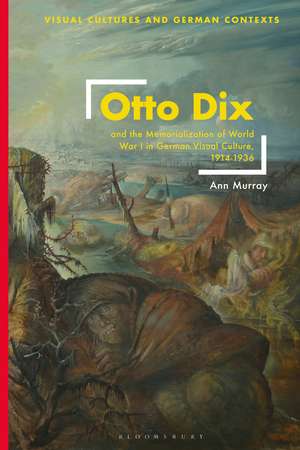Otto Dix and the Memorialization of World War I in German Visual Culture, 1914-1936: Visual Cultures and German Contexts
Autor Ann Murrayen Limba Engleză Hardback – 29 noi 2023
Preț: 542.84 lei
Preț vechi: 775.48 lei
-30% Nou
Puncte Express: 814
Preț estimativ în valută:
103.89€ • 108.06$ • 85.76£
103.89€ • 108.06$ • 85.76£
Carte disponibilă
Livrare economică 24 martie-07 aprilie
Preluare comenzi: 021 569.72.76
Specificații
ISBN-13: 9781350354623
ISBN-10: 1350354627
Pagini: 240
Ilustrații: 54 bw illus
Dimensiuni: 156 x 234 x 23 mm
Greutate: 0.68 kg
Editura: Bloomsbury Publishing
Colecția Bloomsbury Visual Arts
Seria Visual Cultures and German Contexts
Locul publicării:London, United Kingdom
ISBN-10: 1350354627
Pagini: 240
Ilustrații: 54 bw illus
Dimensiuni: 156 x 234 x 23 mm
Greutate: 0.68 kg
Editura: Bloomsbury Publishing
Colecția Bloomsbury Visual Arts
Seria Visual Cultures and German Contexts
Locul publicării:London, United Kingdom
Caracteristici
Provides close examinations of a variety of Dix's artworks, including his War triptych, regarded by some as the most famous German painting of the 20th century yet under-researched by contemporaries and today's art historians alike
Notă biografică
Ann Murray is an independent scholar from Ireland. She is the editor of Constructing the Memory of War in Visual Culture since 1914: The Eye on War (2018).
Cuprins
List of IllustrationsNote on TranslationsList of AbbreviationsAcknowledgementsIntroduction1. 1914-19182. The War Amputee as Anti-Icon3. Disenchanting Mars: The Trench and The War4. Metropolis as War Memorialisation 5. War at the Prussian Academy of Arts6. The Fate of the War Pictures in the Early Years of the Third ReichConclusionSources and BibliographyIndex
Recenzii
Based on an impressive collection of archival material, this study explores critical responses to Dix's work, including National Socialist views and post-war memorialisation.
Murray's deeply researched analysis reveals Dix as a trenchant critic of Weimar-era and wartime Germany. Paying close attention to the artist's critical reception, Murray demonstrates Dix's profound engagement with the politics of war commemoration and the memory of trauma.
Murray's deeply researched analysis reveals Dix as a trenchant critic of Weimar-era and wartime Germany. Paying close attention to the artist's critical reception, Murray demonstrates Dix's profound engagement with the politics of war commemoration and the memory of trauma.














